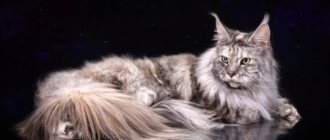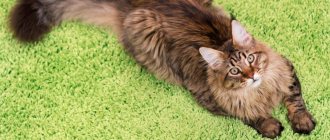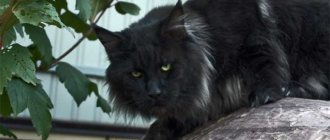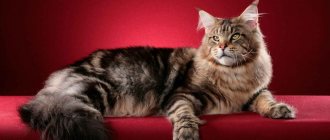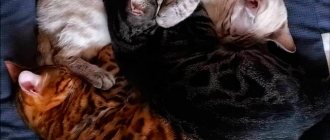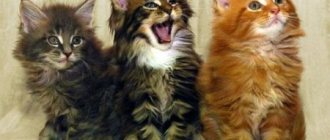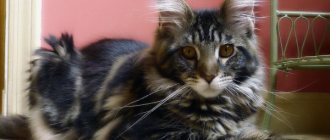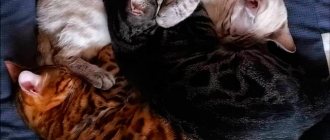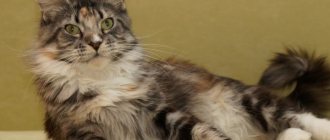Description of the Maine Coon kitten
Let's face it, the main motivation for getting a Maine Coon kitten is the pet's unusual appearance. And this manifests itself literally from the first days of life. The fact is that such a kitten is noticeably larger than ordinary kittens, and by three months of life it reaches the size of an ordinary large cat.
Such a baby has a massive head and a large oblong body with weighty legs. But what is most touching is the thick fur on the nape of the neck, which creates a resemblance to a lion’s mane on a Maine Coon kitten, and the cute tassels on the ears, very reminiscent of lynx tufts.
The look is completed by thick fur with a chic fluffy tail. But the color can be absolutely anything - white, red, gray, smoky, black, or even tri-color.
How to choose a Maine Coon kitten
It must be said that the enormous popularity of Maine Coon kittens has contributed to the appearance of unscrupulous sellers on the market who, under the guise of a real Maine Coon, sell mixed-breed or even outbred kittens. To avoid scammers, pay attention to the following points when purchasing:
- Buy a kitten only from trusted breeders who professionally breed Maine Coons. Such people will not risk their reputation.
- Be sure to check the pedigree of both parents of your future pet. By the way, by observing the parents, you can imagine the character of your future pet and decide whether it is suitable for you.
- Pay attention to the sizes. A Maine Coon kitten is two or even three times larger than ordinary kittens. Girls are slightly smaller than boys, but they also surprise with their size.
- Do not buy a Maine Coon kitten until it is 3 months old. By this age, the baby shows all the signs of the breed. He already has a characteristic mane and tufts on his ears, which means that cunning sellers will not be able to fool you.
Maine Coon and its specifics
Representatives of the breed stand out among other domestic cats primarily due to their large size. Moreover, this is a rare case when appearances turn out to be deceiving. Animals are famous for their gentle nature and playfulness. The animal will quickly find a common language with older children and become their faithful friend.
The main character traits of the Maine Coon are:
- intelligence;
- affectionateness;
- energy;
- calmness.
The breed, by and large, has only one drawback. A Maine Coon will not be able to get along in a house where, besides itself, there are also other, small pets such as hamsters, rats, etc. Instincts will prevail, and other “tenants” will become the object of hunting.
Dimensions of a Maine Coon kitten at birth
According to observations, buyers usually strive to purchase the largest kitten from the litter. However, its size at birth may vary. For example, the average weight of a newborn Maine Coon is 150 grams (while the weight of a regular kitten is 70-80g).
The size of a newborn baby can also be affected by:
Floor. Boys are usually born larger than girls. If a boy in a litter weighs 160g, then a girl weighs 130g.
Number of kittens in the litter. If a cat gives birth to one cub, it can reach a weight of 170 grams, while when 4-5 kittens are born, their average weight will not exceed 140 grams.
Parents' size. The larger the baby's parents, the more he will weigh at birth. By the way, looking at the appearance of your future pet’s mom and dad, you can roughly imagine what your Maine Coon will look like.
Purebred breed. The admixture of cats of other breeds also affects the size of the kitten. It may be significantly smaller than normal size.
Hormonal therapy. If a cat was given hormonal drugs during pregnancy, this could affect the weight of the resulting litter.
Stress. Cats that have experienced a shock, such as separation from their owners or moving to a new place of residence, can also give birth to smaller kittens. By the way, this will also affect their further growth.
Feeding. Finally, the size and weight of the offspring is largely determined by the nutrition that the mother cat received.
Important! A weakened cat gives birth to weakened kittens. They will gain weight more slowly and worse.
Periods of development of a Maine Coon kitten
In general, the development of a Maine Coon kitten goes through 4 periods until it reaches adulthood:
1. Neonatal. This is the period of the first days of a newborn mole rat’s life, when it feeds exclusively on mother’s milk, and its weight gain is largely determined by the severity of the cat’s birth.
2. Suction. This includes the first month of the kitten's life. At this time, he actively feeds on his mother’s milk, gaining 20-30g in weight every day.
3. Transitional. The name of this period clearly indicates that the matured kitten learns to feed on its own. The transition period covers the second month of a kitten’s life, and its weight gain becomes less (10-20g per day).
4. After suction. This is a long period of time, starting from the age of two months and ending with the full adulthood of the Maine Coon. It is characterized by the kitten's weaning from its mother and the transition to independent feeding. At this time, the baby is actively gaining weight and this process actually continues up to 3 years.
Important! The Maine Coon grows up to about 3 years of age. It is by the age of three that a cat matures both physically and psychologically. However, for another 1-2 years the pet can mature, gaining weight and becoming wider.
Where can I buy
Knowing how much they are asking for a Maine Coon now is not enough.
You need to understand where you should buy a kitten, and which offers you should refuse. It is also important to have a good understanding of the characteristics of the breed, current standards, etc. There are known cases when cunning swindlers sold simple kittens under the guise of Maine Coons. The deception is usually revealed only after the animal has matured.
To avoid becoming a victim of scammers, the purchase should be made in a trusted nursery that specializes only in the breed in question. Here, along with the kitten, they also issue documents confirming both the transaction itself and the purity of the animal.
Buying an animal through an advertisement is a riskier undertaking, but in this case it is usually possible to save a very hefty amount. When choosing this method, you need to find out more about the seller. The ideal option is to search through friends and acquaintances. Be sure to demand to see the parents of the proposed kitten - it must at least resemble them (at least like its mother).
There is a big risk of acquiring a defective animal by making a deal with the owners of a conveyor nursery. There are also many of these now. Here cats are kept only for the sake of breeding - they are fed poorly and are practically not looked after. As a result, babies turn out weak and sickly. Such organizations usually sell young animals that are not yet three months old. Animals are often not even vaccinated.
Development of a Maine Coon kitten by month
• 1st month. Immediately after birth, the kitten arrives in stress and gains very little weight. However, then he goes into a routine, starting to eat actively and steadily gain about 20g per day. It is not surprising that by the first month of life the baby exceeds its original weight by almost 4 times. Maine Coon boys weigh about 800g, and girls about 600g.
Important! Around the second week of life, the little cub opens its eyes and begins to explore the world.
• 2 months. The baby continues to feed on mother's milk in the same mode, and therefore the weight increases proportionately. As a result, by the second month of life, boys of this breed weigh 1600 grams, and girls - 1400 grams. However, at this time you can already begin to introduce complementary foods to your baby. This can be boiled meat pureed, baby yoghurts or cottage cheese.
In addition, the kitten is already ready to learn everything new. He masters the tray and enjoys playing with toys. The mother cat plays a huge role in teaching the baby, teaching the baby the rules of behavior, in particular, showing how and where to sharpen its claws.
• 3 months. A three-month-old kitten can be gradually weaned off its mother's milk. The baby is already quite ready to consume dry and wet food, and should eat 4-5 times a day.
In addition, by the age of three months, the little Maine Coon must visit a veterinary clinic and receive all the necessary vaccinations, as well as a veterinary passport.
Important! By the age of three months, the difference in weight between male and female coons becomes noticeable. In addition, kittens exhibit all the characteristic features of this breed.
• 4 months. Around this period, the young Maine Coon finds new owners and moves to a new home. These events become stressful for the animal, and therefore it is possible that the kitten begins to gain weight more slowly. At the same time, the pet goes to the toilet tray without prompting and can be trained.
• 5 months . By the age of five months, the Maine Coon transforms from an angular kitten into a beautiful purebred cat. Its weight, depending on gender, varies between 3-5 kilograms. Growth at this age slows down somewhat, but weight continues to increase.
• 6-9 months. By this period, the cat's baby teeth fall out and permanent teeth appear. Therefore, more foods with calcium (boiled fish, fermented milk products) should appear in his diet. And by this age, the Maine Coon begins to be given frozen meat periodically. To do this, beef cubes are simply frozen in the freezer for a couple of days and given to the cat as a treat.
Moreover, the animal is already going through puberty, which means that the ideal time has come for castration or sterilization if the owners do not plan to further breed Maine Coons.
By the age of one year, the average weight of a Maine Coon is close to 8-9 kilograms. You should not overfeed your pet in pursuit of records. This way you will only harm your four-legged friend by causing obesity, cardiovascular diseases, hormonal imbalance and other serious illnesses that affect life expectancy.
Important! Experts recommend that caring owners keep a diary and note in it the weight and height of the Maine Coon kitten during the first year of life. This will allow you to promptly identify possible deviations if they appear and seek help from a veterinary clinic.
Color classification
All colors of Maine Coon cats can be divided into categories: with a pattern or tabby; without a pattern or solid; tortoiseshell; smoky and silver.
Drawing (tabby)
The Maine Coon Tabby has the following traits:
- stripes on the forehead in the shape of the letter "M"
- eyes and nose mirror are outlined in dark
- there are dark stripes on the sides of the muzzle
- stripes on the chest form a “necklace”
- horizontal stripes on paws
- small spots on the belly
The drawing itself comes in 4 types:
- Marble or classic (blotched/classic). There are rounded marks on the sides; a “butterfly” is possible between the shoulder blades. And solid lines along the spine.
- Tiger (mackerel). There are solid vertical stripes on the sides and a dark stripe along the spine.
- Spotted. Pattern in the form of small spots or dotted stripes.
- Ticked. The drawing is only on the face. Each hair ends in a dark color. The ticked color of Man-Coons is not typical and is typical of Oriental breeds.
People often use the name “wild” or “forest”. Underneath is the black marbled color of the Maine Coon n22.
n 22 – black marbled tabby
n 23 09 – black brindle tabby with white
d 24 – red spotted tabby
a 25 – blue ticked tabby
Solid (solid)
A solid colored cat should have a uniform color throughout the body. Breed standards assume that the coat color is rich and the hairs are dyed from base to tip. The disadvantage is the residual pattern, including on the head, as well as a lighter undercoat (than the main color). Markings of a different color are considered defective.
In Maine Coons, solid is represented by 5 colors:
- Black
- Red
- White
- Blue
- Cream
Some colors are not allowed in the breed standard. The unrecognized colors of the Maine Coon are: gold, chocolate, cinnamon, fawn, lilac and color point.
The black Maine Coon cat has a stunning look. It needs to be combed more often than others. This way, fur renewal occurs faster and dead brown hairs do not remain. This is especially true during the molting period. For a healthy and beautiful coat, you need to provide your pet with proper nutrition. Maine Coons with a black coat are the most difficult to prepare for a show. Dead hairs are brownish in color, while new ones are gray, which darkens over time. You need to make sure that the wool in the collar area and on the “pants” does not have a different color cast.
If a Maine Coon is born black with a white spot, then it is already a bicolor color.
n – black solid
The red color of the Maine Coon includes all shades. Most often you can hear the name red Maine Coon. Due to the strong tabby gene, it is very difficult to achieve the absence of a pattern in a Red Maine Coon. Therefore, it is slightly visible, but still present in the solid.
d – red solid
You can't go past the luxurious white Maine Coon cat. As stated earlier, this color is not a color. This is rather a lack of color in the Maine Coon, because the hair does not have color pigment. A small kitten may have color markings on its face that fade over time. Pets are not fussy to care for. White Maine Coons come with blue eyes and multi-colored eyes (one is blue and the other is green). The completely green iris of the eyes is characteristic of the silver color (description below). It is worth noting that such kittens have a risk of being born deaf. Therefore, it is better to choose a snow-white miracle from experienced breeders: crossing two white individuals is prohibited.
w 62 – white with yellow eyes
Maine Coons of the blue solid color are not very common in the CIS countries. Their fur is ash-gray in color, with a certain blue tint. Probably because of him, blue Maine Coons became popular in Europe.
a – blue solid
The cream Maine Coon is obtained by lightening the red color. The color has warm shades of ginger. Achieving pure colors is problematic due to the progression of classical genes in the Maine Coon.
e – creamy solid
Tortoiseshell
There is an opinion that cats with a combination of several colors bring good luck. A black tortoiseshell Maine Coon can be a torby or a tortie depending on the number of colors. Torbi includes red and black (brown). Torti adds cream color. The lightened classic tortoiseshell coloring is called blue-cream.
Interesting! Most cats are born with tortoiseshell coloration. The chance of having a boy is 1 in 1000.
Tortoiseshell cats can be additionally smoky or silver.
f 22 – black tortoiseshell marbled tabby
g – blue-cream tortoiseshell solid
In addition, the color may be missing or have white markings of varying sizes. A Maine Coon with white spots that have distinct edges is called a calico. Translated as “chintz” or “flap”. Calicos are characterized by the presence of red spots with a pattern. Blue-cream Maine Coons, with a spotted pattern or diluted calico (calico) may also have white markings.
f 09 – black solid turtle with white
Silver and smoke
Smoky Maine Coons always produce an impressive effect. A distinctive feature of the color is the presence of a perfectly white root zone in the coat. Do not go with a lightened or grayish color.
Smoky coloring has its own categories:
- normal – hair is half dyed
- shaded – the hair is colored by a quarter
- chinchilla – one-eighth of the hair is dyed
Black Smoke Maine Coons, like Blue Smoke, have a rich base color along with white roots. Tortoiseshell can also be smoky.
ns – black smoke
If a cat with a white undercoat has a pattern, then this color is called silver. As a rule, such kittens are born very light. As they grow older, the fur begins to darken and the pattern becomes brighter. Coloring is determined at a young age by eye color. The silver color has green eyes, and the blue color has white eyes.
fs 22 – black silver tortoiseshell marbled tabby
In red smoke (silver) kittens, the coat pigment is weakly visible. They are born light-colored, which is why they are called “cream” or “cameo.”
ds 23 – red silver (cameo) brindle tabby
White spots
White spots can be in addition to the main color. Depending on the size and location, the division occurs:
- Van is an almost white individual with several spots on the head and tail, and occasionally on the body.
- Harlequin - Larger spots of color are located on the main white background.
- Bicolor (bi-color) – the ratio of white and main color is 50/50.
- Locket - a white spot located on the chest.
- Gloves (mitted) – white spots on the ends of the paws, as if wearing “socks”.
- Tuxedo (tuxedo) – white spots are located on the chest and paws, possibly on the head.
- Buttons – several small white spots.
n 03 – black and white bicolor
n 01 – black and white van
In conclusion, we can say that Maine Coons do not have rare colors. Even a red Maine Coon or a black merle can be rare if they are unique based on the coloring of their parents. You also need to understand that the same color will look different on two kittens.
If the kitten is not gaining weight
Typically, a similar problem occurs when the coon is not fed correctly. Perhaps the kitten simply does not have enough food that its owners give it. Still, this is a rather large cat. Try to gradually increase your diet and record the results in your diary every day (it’s better to weigh your cat on an electronic scale).
It is possible that the inhibition of weight gain is due to a lack of certain nutrients. This happens especially often with calcium deficiency. In any case, to find out the reason, it is better to take the kitten to a veterinary clinic and undergo an examination.
By the way, practice shows that owners who feed their pets dry food are less likely to encounter weight problems. But those who strive to feed their pets homemade food often experience problems with the balance of nutrients.
Therefore, listen to the recommendations of veterinarians, get vaccinations on time and regularly come for examination with your ward. Compliance with all the rules and recommendations will allow you to raise a beautiful, and most importantly, healthy Maine Coon!
